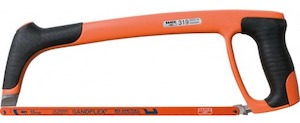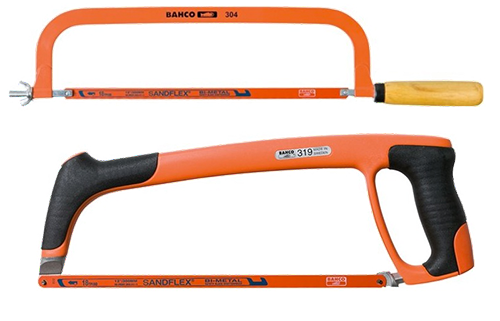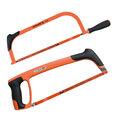What is a Hacksaw Tool & How to Use It

Figure 1: A hacksaw
Hacksaws have hard blades and small teeth designed for cutting through metal or plastic. They are commonly used by homeowners and hired professionals to cut out a section of piping to replace or install a valve, such as a ball valve or check valve. This article closely examines hacksaw designs, their blades, and how to use a hacksaw.
Table of contents
View our online selection of hacksaws!
Hacksaw design

Figure 2: Two different hacksaw designs. Above a straight design, and below a pistol-type design.
The basic hacksaw design varies between the frame type and the blade that attaches to the frame, and they typically have a pistol type handle.
- Adjustable: These frames can extend or reduce in length to accommodate different blade lengths.
- Fixed: These frames, as shown in figure 2, cannot change length and therefore can only use one blade length.
Hacksaw blades vary by length, material, and TPI (teeth-per-inch).
- Length: Most hacksaw blades are 150, 254, or 300 mm long (6, 10, or 12 inches).
-
Material: Common materials are classified by:
- Bimetal material: Bimetal hacksaw blades typically have high speed steel teeth electron beam welded onto spring steel. This combination provides heat resistance and flexibility.
- High speed steel: High speed steel can withstand higher temperatures without losing its temper (toughness and hardness).
- Carbon steel: Carbon steel blades are suitable for DIY and general workshop applications (e.g., cutting screws). Also, due to its flexibility, carbon steel is commonly used as the body material for bimetal material blades.
- TPI (teeth-per-inch): 18, 24, and 32 TPI blades are suitable for most jobs. Higher TPI blades make finer cuts but also cut slower. Learn more about selecting the right TPI by reading our hacksaw blade selection article.
Hacksaw components
Beyond the frame, handle, and blade, other common components of a hacksaw are the following:
- Variable screw: Also known as the adjustable screw, this controls the adjustment of adjustable frames.
- Wingnut: The wingnut controls how much tension is on the hacksaw blade.
How to use a hacksaw tool
The following steps make any hacksaw application safe and efficient:
- Safety precautions: Hacksaws are generally safe since the teeth are soft to the touch. However, keep hands and body away from the saw when using it. Wear gloves and safety glasses while cutting. Finally, ensure that the blade is properly tensioned to reduce the risk of it breaking during operation and becoming a hazard.
- There is no quantitative way to measure whether or not a blade is properly tensioned. Knowing whether the blade is or is not properly tensioned comes from advice and experience. The general recommendation is to tighten the wingnut until the blade is tight and then tighten it further by turning it fully three more times.
- Prepare the working material: Properly clamp the pipes so they won’t move too much. Clamp flat material to a work table.
- Also, apply a few drops of machine oil to the hacksaw blade. Oil reduces friction while cutting, which reduces the temperature and the chance of the blade losing its temper (toughness and hardness).
- Finally, ensure that the teeth of the hacksaw blade are directed forward and not backward.
- Start the cut: Use a pencil or chalk to mark where the material will be cut. Start cutting by moving the hacksaw slowly in short strokes until a groove forms.
- Finish the cut: Once a groove forms, use the entire length of the hacksaw blade to make smooth cuts. Apply pressure on forward strokes and let up the pressure on backward strokes. Applying pressure while pulling back doesn’t cut any more material, but it can eventually dull the teeth off. Continue this way until the cut is finished.
After the material is cut, use a deburring tool and sandpaper to remove any rough edges and smoothen the end points. Also, put a hacksaw blade cover on the hacksaw to protect the blade while storing it. Read our hacksaw blade replacement article for more information on how to replace a hacksaw blade.
Hacksaw tool applications
As previously mentioned, hacksaws are ideal for cutting plastic and metal. Hacksaws with low TPI can cut wood well, but a regular handsaw or traditional frame saw are better suited for wood. Hacksaws are not a good option for cutting stone. For stone, use a circular saw with a diamond blade.
Some common applications of hacksaws are:
- Cut galvanized or steel pipes: Using a hacksaw is faster than taking the time to set up a powered saw.
- Metalworking: Useful when bar stock needs to be cut quickly.
- Plumbing: Plumbers use hacksaws to cut metal and plastic piping.
- Wrought iron and cast iron: Hacksaws are strong enough and have enough applied pressure to cut through these hard metals.
- Construction: Hacksaws are useful in many ways, for example, cutting rebar.
- Bolt and screw trimming: Use a hacksaw to quickly solve the issue of bolts and screws being too long.
- Woodworking: As mentioned above, hacksaws are not the most suitable saw for woodworking, but they can be used.
- Frozen meat: Hacksaws are excellent for cutting large slabs of frozen meat.
FAQs
Can a hacksaw cut an exhaust pipe?
It is possible to cut an exhaust pipe with a hacksaw. The hacksaw is not the most efficient tool to use, but it is a budget-friendly option. Circular saws are great for cutting exhaust pipe.
What is the difference between a saw and a hacksaw?
A saw is designed for cutting through wood, whereas a hacksaw is designed for cutting through metal and plastic.
Can a hacksaw be used to cut wood?
Yes, a hacksaw can cut through wood. A handsaw or traditional frame saw are better for woodcutting, though.





